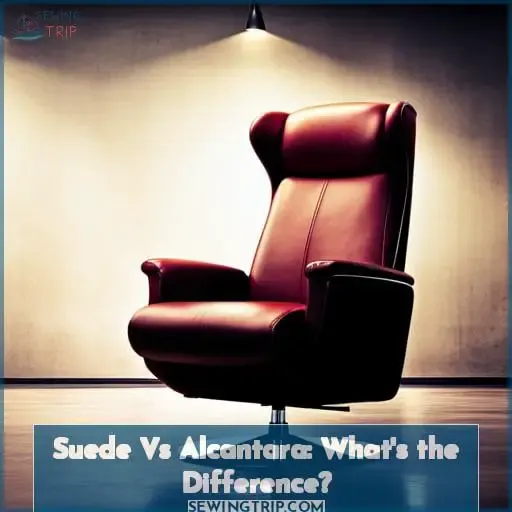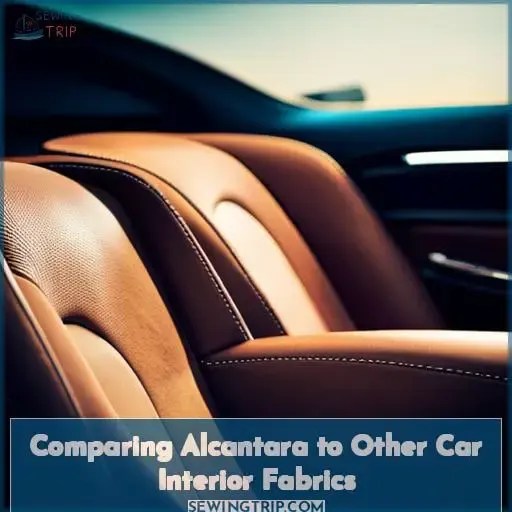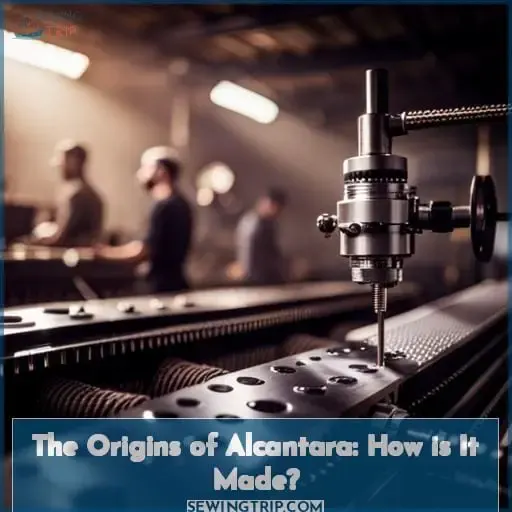This site is supported by our readers. We may earn a commission, at no cost to you, if you purchase through links.
 Are you in the market for a new car interior fabric? If so, it’s important to understand the differences between suede and alcantara. Both fabrics offer superior comfort and look great, but there are some key differences that set them apart.
Are you in the market for a new car interior fabric? If so, it’s important to understand the differences between suede and alcantara. Both fabrics offer superior comfort and look great, but there are some key differences that set them apart.
To help you decide which is best suited for your needs, let’s explore the pros and cons of both materials as well as their origins and uses in automotive interiors.
From grip to durability to maintenance costs – we’ll cover all aspects of suede vs alcantara so you can make an informed decision when choosing your next car interior fabric!
First, suede is made from the underside of animal hides, usually from goats, lambs, calves or deer. It has a soft napped surface and velvet-like texture. Suede provides excellent grip, so it won’t slip out of your hands easily while driving.
However, it stains easily and requires special cleaners. It also wears out over time.
Alcantara, on the other hand, is a synthetic microfiber material made in Italy. It offers a suede-like texture and appearance, but with more durability and easier maintenance. Alcantara is stain resistant and can be cleaned with mild soap and water. It also retains its appearance better over time compared to suede.
When it comes to automotive applications, both suede and alcantara are popular upholstery choices for luxury vehicles. Suede conveys natural luxury and sophistication. Alcantara offers a more practical and cost-effective alternative with similar aesthetics.
So in summary, suede has a more premium feel, while alcantara is more durable and easier to maintain. Consider your priorities – if you want indulgent luxury, go for suede. But if practicality matters more, alcantara may be your best bet.
Weighing the pros and cons of each will help you decide which interior fabric makes the most sense for your next car.
Table Of Contents
Key Takeaways
- Suede is made from animal hides and requires special cleaners, while Alcantara is a synthetic microfiber that is easy to maintain with mild soap and water.
- Alcantara has superior grip, a matte finish, and is more durable when compared to suede.
- Alcantara is commonly used in the automotive, aerospace, and fashion industries. In contrast, suede is popular for its natural variations and soft grip.
- Alcantara is composed of polyester and polyurethane fibers, providing advantages such as grip, flame-retardance, aesthetics, durability, and easy cleaning.
Alcantara Vs. Suede: What’s the Difference?
You’d feel the difference between alcantara and suede the moment you run your hand across them—the synthetic weave of alcantara’s got a uniform softness while the real hide of suede’s got subtle variations that just can’t be replicated.
Though they share a suede-like appearance and soft touch, alcantara’s a trademarked synthetic polyester and polyurethane blend whereas true suede’s tanned animal hide. Alcantara’s unique strength is its versatility – its custom weave means it can be tuned to specifications like flame retardancy and durability, making alcantara a popular, ethical alternative for automotive, aerospace, fashion and more.
While suede holds prestige as an exotic leather with natural imperfections, alcantara offers a cruelty-free consistency that even mimics suede’s subtle nap.
Ultimately both satisfy a desire for tactile luxury, but their origins and production set them apart.
Pros and Cons of Alcantara
As a fashion journalist, here’s my take on Alcantara’s pros and cons. While its superior grip, matte finish, and durability have catapulted it to darling status for car interiors, regular cleaning and maintenance are critical to preserving its softness and appearance over time.
Alcantara requires more meticulous care than leather or fabric to retain its aesthetic properties. The delicate material pills easily if washed improperly or subjected to rough use. Manufacturers often recommend professional Alcantara cleaning every one to three years.
With proper care, however, Alcantara upholstery retains its luxurious look and feel for the lifetime of a vehicle. Deciding between Alcantara and leather depends on personal priorities – Alcantara’s unique tactile properties or leather’s ruggedness and prestige.
Grip and Finish
Alcantara’s matte grip clings to your hands like a gentle octopus, while suede’s velvety finish slips through your fingers like an eel. The polyester polyschaum core of Alcantara creates a firm, textured structure ideal for proper traction and stability.
Suede’s fuzzy nap fluctuates in density, sacrificing consistency for softness. While suede seduces with its buttery allure, Alcantara excites with the commanding performance of its sturdy weave, empowering your hands as an extension of yourself.
Though different in their tactile profiles, both fabrics ultimately seek to liberate your inner spirit through their sensual touch.
Durability and Maintenance
Making sure you regularly clean and maintain that Alcantara keeps it looking fresh and feeling soft for a long while.
- Use a soft bristle brush weekly to lift dirt from the nap.
- Blot spills immediately with a dry absorbent cloth.
- Vacuum monthly, going gently on any worn spots.
- Every few years, consider professional reconditioning services.
With proper care, Alcantara holds up well compared to real suede and looks sharp much longer. Keeping it clean takes effort but pays off in durability and long-term appearance.
Comparing Alcantara to Other Car Interior Fabrics
Unlike leather or cloth, Alcantara’s texture gives a unique feel while staying durable in high-wear areas.
When selecting automotive upholstery fabrics like Alcantara, leather, or cloth, consider the end-use environment and cleaning requirements. Synthetics like Alcantara offer a sporty feel with durability, but may not provide the prestige of natural leather.
Ultimately, the choice comes down to performance, maintenance and individual preference for your vehicle’s interior.
| Material | Pros | Cons |
|---|---|---|
| Alcantara | Superior grip, stain resistant, light, flame retardant | Fades over time, absorbs oils |
| Leather | Soft, natural feel and scent, luxurious | Heat and wear cause cracking, absorbs stains |
| Cloth | Breathable weave, variety of patterns | Prone to pilling, fading, tearing with high use |
Alcantara in Car Interiors: Where is It Used?
You’ll find Alcantara on the seats, steering wheel, armrests, and dash in high-end performance cars like Ferraris and Lamborghinis.
Seats – Alcantara is used to upholster the seat inserts, side bolsters, and headrests, providing grip and comfort during aggressive driving.
Steering Wheel – An Alcantara-wrapped steering wheel enhances grip and feel while providing a premium look and feel.
Gear Shifter – High-end manual gear shifters are often wrapped in Alcantara for better grip and tactile feedback.
Armrests – Armrests and other touchpoints covered in Alcantara add elegance and improve tactile sensations.
Dash – Using Alcantara on the dash reduces glare and adds a delicate, luxurious accent to the cabin.
Alcantara is widely used in sports cars and luxury vehicles because of its ability to blend high performance with luxury. The suede-like material provides excellent grip, is lightweight, and has a soft, premium feel and appearance that elevates the aesthetics of any vehicle’s interior.
As demand for Alcantara continues to grow, we should expect to see it used more often in high-end and even mainstream automobiles.
The Origins of Alcantara: How is It Made?
The origins of Alcantara: How is it made?
As the trademarked microsuede developed in the 1970s, you’re feeling the heritage of Alcantara through its sporty applications.
- Polyester and polyurethane are spun into fibers.
- The fibers are fused together using high heat and pressure.
- A finishing process adds color and texture.
- Quality control ensures durability, safety, and comfort.
Alcantara S.p.A. trademarked the material, balancing high-performance with sustainability. Composed of 68% polyester and 32% polyurethane, Alcantara transformed car interiors with its soft, grippy finish.
The manufacturing technology evolved over decades, but the sporting spirit remains through Formula 1 and luxury vehicles. Tracing the origins back to Japanese labs, you feel the innovation in the material.
Alcantara stands apart with its technical precision, yet maintains a natural, liberating aesthetic. The material blends cutting-edge technology with an organic look and feel that enhances the driving experience.
Is Alcantara the Superior Choice for Car Interiors?
Thankfully, Alcantara’s lightweight and wear-resistant make-up lets you focus more on driving than durability! This synthetic material boasts some key advantages over suede when appointed in car interiors.
Alcantara offers unbeatable grip, high flame-retardance, and luxurious aesthetic appeal. Its durable construction withstands intensive use while maintaining a soft, suede-like texture. But it’s easier to clean than its natural counterpart – a must for longevity in high-performance vehicles.
With simple maintenance like regular vacuuming and gentle cleaning solutions, Alcantara retains its beauty. While suede has an undeniable richness, Alcantara’s tailored performance benefits let you indulge in luxury without compromise.
Its blend of style, safety, and usability makes it a cut above for discerning drivers. Whether wrapping your hands around the steering wheel or nestling into plush sport seats, you can enjoy Alcantara’s sensual tactility knowing it will outlast and outperform.
Conclusion
In brief, the choice between suede and Alcantara for car interiors is a matter of personal preference. Alcantara is a synthetic material that offers superior grip, durability, and flame-retardancy. Its matte finish and lightness also make it an attractive option for car owners.
On the other hand, leather is more breathable and requires less maintenance. Ultimately, the decision between these two materials depends on the individual’s needs and budget. For those seeking a more luxurious feel, Alcantara is the superior choice. Its soft texture, environmental sustainability, and superior grip make it the perfect choice for car interiors.












